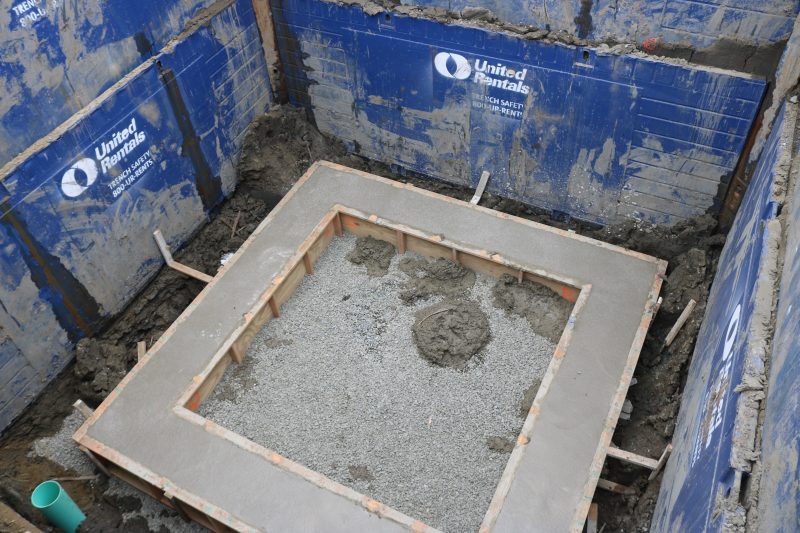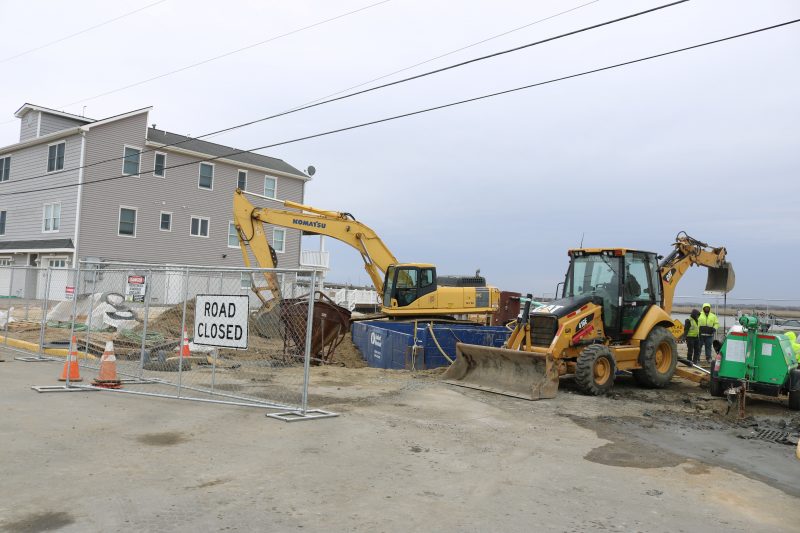Rock walls, like this one running along the side of 38th Street, help contain flooding that seeps out of the marshlands.
 By Donald Wittkowski
“Do you want to see something really cool?” Christopher Mathis asked.
He walked past a chain-link fence and pointed downward to a big, box-like chamber descending 18 feet into the ground.
Mathis, supervisor of Mathis Construction Co. Inc., and his workers started digging the chamber last week at the bay end of 38th Street for what will be Sea Isle City’s first pumping station.
The nearly $800,000 project represents another facet of Sea Isle’s strategy to protect flood-prone areas from stormwater.
Long frustrated with the flooding that inundates their neighborhood, homeowners on 38th Street and the adjacent Sounds Avenue are relieved to hear that the project is finally underway after more than a year of planning and discussion.
“I’m just hopeful that it resolves the flooding problem for us. I personally don’t have anything negative to say about this. I think it’s only going to help us,” said Lou Gryga, a summer resident of Sounds Avenue who has acted as a spokesman for the neighborhood
Mathis Construction, of Little Egg Harbor Township, was awarded a $789,580 contract to build the pumping station. Christopher Mathis was unsure when the project will be completed, but Gryga said he has heard it should be done within a month to six weeks.
By Donald Wittkowski
“Do you want to see something really cool?” Christopher Mathis asked.
He walked past a chain-link fence and pointed downward to a big, box-like chamber descending 18 feet into the ground.
Mathis, supervisor of Mathis Construction Co. Inc., and his workers started digging the chamber last week at the bay end of 38th Street for what will be Sea Isle City’s first pumping station.
The nearly $800,000 project represents another facet of Sea Isle’s strategy to protect flood-prone areas from stormwater.
Long frustrated with the flooding that inundates their neighborhood, homeowners on 38th Street and the adjacent Sounds Avenue are relieved to hear that the project is finally underway after more than a year of planning and discussion.
“I’m just hopeful that it resolves the flooding problem for us. I personally don’t have anything negative to say about this. I think it’s only going to help us,” said Lou Gryga, a summer resident of Sounds Avenue who has acted as a spokesman for the neighborhood
Mathis Construction, of Little Egg Harbor Township, was awarded a $789,580 contract to build the pumping station. Christopher Mathis was unsure when the project will be completed, but Gryga said he has heard it should be done within a month to six weeks.
 Mathis Construction Co. Inc., the project's contractor, is using heavy machinery to build the pumping station at the bay end of 38th Street.
The pumping station is designed to intercept floodwater and channel it back into the bay much faster than it would normally take after a coastal storm.
“I’ve worked around these for a long time and they seem to work very well,” Mathis said of pumping stations he has built in other towns.
Although the pumping station is regarded as a dramatic improvement, it will not stop flooding in major storms, Sea Isle Business Administrator George Savastano said in an earlier interview.
Mathis Construction Co. Inc., the project's contractor, is using heavy machinery to build the pumping station at the bay end of 38th Street.
The pumping station is designed to intercept floodwater and channel it back into the bay much faster than it would normally take after a coastal storm.
“I’ve worked around these for a long time and they seem to work very well,” Mathis said of pumping stations he has built in other towns.
Although the pumping station is regarded as a dramatic improvement, it will not stop flooding in major storms, Sea Isle Business Administrator George Savastano said in an earlier interview. Rock walls, like this one running along the side of 38th Street, help contain flooding that seeps out of the marshlands.
Noting that flooding seems to be getting worse from the marshlands, Gryga said that he plans to ask the city to install even more of the rock walls – also known as berms – to serve as a first line of defense for the bayfront homes lining Sounds Avenue.
“These berms they’ve put in are helpful as well,” he said in an interview Sunday. “But we’re going to take one thing at a time. It’s very exciting.”
Last June, the city completed the repaving of 38th Street from Central Avenue to Sounds Avenue. The street was regraded and repaved to even out its undulating surface caused by the construction of a new stormwater pipe leading to the bay.
Construction of the pumping station is next. Although a gaping, 18-foot-deep hole has been dug now for the pumping station’s chamber, it will be filled over and the bay end of 38th Street will be repaved when the project is completed. The three pumps comprising the station will be under the street, completely out of view from homeowners, Mathis explained.
The only thing that will be visible will be an electrical panel mounted on a 7-foot-high platform, he said. The panel will contain the controls for the pumping station.
At least one homeowner has asked whether the pumping station will make a lot of noise when it is working, Mathis noted.
He assured it will be relatively quiet.
“It will be nothing anybody will be annoyed about. You might hear the water splashing around the pipe when it’s turned on,” Mathis said about the sound the pumping station is expected to make.
Rock walls, like this one running along the side of 38th Street, help contain flooding that seeps out of the marshlands.
Noting that flooding seems to be getting worse from the marshlands, Gryga said that he plans to ask the city to install even more of the rock walls – also known as berms – to serve as a first line of defense for the bayfront homes lining Sounds Avenue.
“These berms they’ve put in are helpful as well,” he said in an interview Sunday. “But we’re going to take one thing at a time. It’s very exciting.”
Last June, the city completed the repaving of 38th Street from Central Avenue to Sounds Avenue. The street was regraded and repaved to even out its undulating surface caused by the construction of a new stormwater pipe leading to the bay.
Construction of the pumping station is next. Although a gaping, 18-foot-deep hole has been dug now for the pumping station’s chamber, it will be filled over and the bay end of 38th Street will be repaved when the project is completed. The three pumps comprising the station will be under the street, completely out of view from homeowners, Mathis explained.
The only thing that will be visible will be an electrical panel mounted on a 7-foot-high platform, he said. The panel will contain the controls for the pumping station.
At least one homeowner has asked whether the pumping station will make a lot of noise when it is working, Mathis noted.
He assured it will be relatively quiet.
“It will be nothing anybody will be annoyed about. You might hear the water splashing around the pipe when it’s turned on,” Mathis said about the sound the pumping station is expected to make.